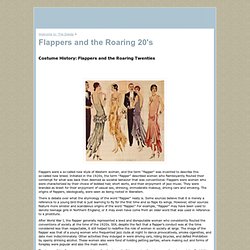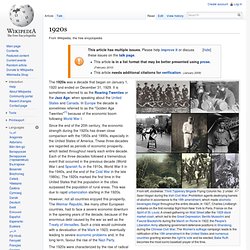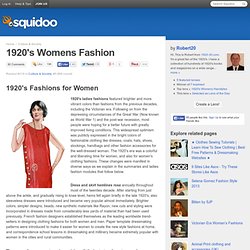

1921-1929. The 1920s - Also known as the Roaring Twenties. Flappers and the Roaring 20's - www. Flappers were a so-called new style of Western woman, and the term “flapper” was invented to describe this so-called new breed.

Initiated in the 1920s, the term “flapper” described women who flamboyantly flouted their contempt for what was back then deemed as societal behavior that was conventional. Flappers were women who were characterized by their choice of bobbed hair, short skirts, and their enjoyment of jazz music. They were branded as brash for their enjoyment of casual sex, drinking, immoderate makeup, driving cars and smoking. The origins of flappers, ideologically, were seen as being rooted in liberalism. There is debate over what the etymology of the word “flapper” really is. After World War I, the flapper generally represented a lewd and disreputable woman who consistently flouted the conventions of society at the time of the 1920s. The image of the flapper was something of a direct result of the popular disgust among Americans at the Prohibition laws.
1920 - key events. 1920s. The 1920s was a decade that began on January 1, 1920 and ended on December 31, 1929.

It is sometimes referred to as the Roaring Twenties or the Jazz Age, when speaking about the United States and Canada. In Europe the decade is sometimes referred to as the "Golden Age Twenties"[1] because of the economic boom following World War I. Since the end of the 20th century, the economic strength during the 1920s has drawn close comparison with the 1950s and 1990s, especially in the United States of America. These three decades are regarded as periods of economic prosperity, which lasted throughout nearly each entire decade. Each of the three decades followed a tremendous event that occurred in the previous decade (World War I and Spanish flu in the 1910s, World War II in the 1940s, and the end of the Cold War in the late 1980s).
The 1920s were characterized by the rise of radical political movements, especially in regions that were once part of empires. Social history[edit] Wars[edit] Asia[edit] American Cultural History - Decade 1920-1929. Early modernism in art, design, and architecture, which began at the turn of the century, continued through to 1940 and the war.

In cities, Skyscrapers (first in 1870s) were erected and hundreds of architects competed for the work. The first successful design was the Woolworth Building in New York. In Chicago, the Wrigley building was designed by Graham, Anderson, Probst, and White while the Chicago Tribune Tower was designed by Howells and Hood. The Art Deco design was exemplified by the Chrysler and Empire State Buildings (depression projects - the Empire State Building completed early 1931.)
Frank Lloyd Wright was prolific during this period, designing homes in California and in Japan. Art movements included the modernist movement [George Luks, Charles W. 1920′s Womens Fashion. Cosmetics of any kind, especially rouge, lip Sticks, and powder, if used, should be of excellent quality in order to be safe.

And by excellent quality I mean the kinds that are manufactured by reputable firms and indorsed in advertisements by leading magazines. There is danger in cheap powder because of the metallic substance used for its foundation. More expensive powders, those with rice as their base, dust off more easily than do the cheaper grades. If you feel that the standard brands are too expensive for you, purchase toilet rice flour. It comes in packages, the same as powder, and is usually unscented, but it gives a fresh, clean appearing surface and is not injurious.
There are several colors of face powders: white, flesh, pink, brunette, and tan. The natural color of the Anglo-Saxon is a soft, creamy color, with a noticeable flush on cheeks and lips. For the brunette with a creamy complexion, flesh-colored powder is preferred.